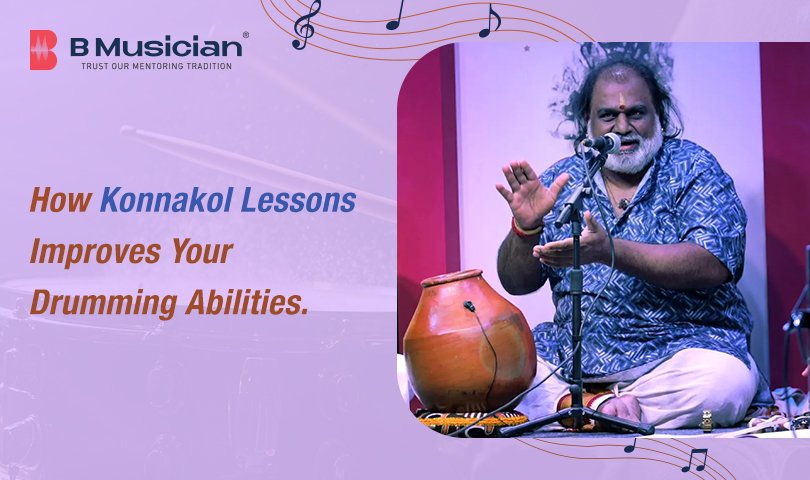Konnakol: The Fascinating Art Form of Vocal Percussion
Konnakol, a captivating vocal percussion art form from South India, has become an important feature in global music today. Known for its rhythmic precision and fluidity, Konnakol has intrigued musicians and enthusiasts worldwide for its intricate patterns and cultural significance. This has propelled the growth of this art form to be learnt and sought after enabling way to course like online drum lessons and online Konnakol lessons etc. In this blog, we will explore the origins, growing popularity, and the numerous benefits of this distinctive art form.
Origin of Konnakol - Roots in Carnatic Music
Konnakol has its origins in the classical music tradition of South India, specifically the Carnatic music system. Carnatic music, which is based on intricate rhythm cycles known as “tala,” uses vocal percussion as a means of elaborating these rhythms. Konnakol is the art of vocalizing these rhythmic patterns, typically used as a substitute for percussion instruments in performance.
Historically, Konnakol was practiced by highly skilled percussionists and vocalists who would recite complex rhythmic sequences using syllables. These syllables represent the sounds of various percussion instruments, especially the “mridangam,” a two-headed drum used in Carnatic music. Over time, this vocal art form became an essential aspect of Carnatic music, serving both as a teaching tool and a method of improvisation. Today, the influence of Konnakol extends beyond traditional settings, inspiring rhythm enthusiasts worldwide, including those exploring online drum lessons, to deepen their understanding of rhythm and improvisation.
Cultural Significance
In the cultural context of South India, Konnakol is not just a musical expression but also a form of storytelling and spiritual practice. It is often performed in temples during religious events, and its rhythmic complexity is believed to connect the performers with the divine. The syllables in Konnakol are deeply tied to the sacred rhythms that have been passed down through generations.
Gaining Popularity Among Musicians and Learners
Konnakol in Modern Music
While Konnakol is traditionally linked to Carnatic music, its appeal has transcended regional boundaries. The art form has found a place in contemporary music genres like jazz, fusion, and world music. Renowned musicians like Shri Zakir Hussain (tabla virtuoso) and John McLaughlin (jazz guitarist), Shri vikkuvinayakaram (Gatam virtuoso) have embraced Konnakol, integrating its rhythm patterns into their performances.
The growing popularity of world music and global fusion genres has allowed Konnakol to reach international audiences. Musicians outside India are drawn to its rhythmic intricacy, incorporating it into their compositions, collaborating with Indian artists, or experimenting with the unique percussive sounds it offers.
Konnakol in Music Education
In recent years, Konnakol has also gained traction as an educational tool for music students. Many music schools and academies around the world are introducing Konnakol as part of their curriculum. It is an excellent method for developing a sense of rhythm, timing, and musicality. As students learn to vocalize intricate rhythms, they develop a deep understanding of rhythm cycles that are central to many music traditions.
The accessibility of Konnakol as a purely vocal art form (requiring no instrument) makes it a valuable tool for learners at all levels. Enthusiasts and aspiring musicians are using online tutorials, YouTube channels, and specialized workshops to learn and practice Konnakol, furthering its reach globally.
Konnakol - how does It improve your drumming abilities:
| Aspect | Impact on Drumming | Examples/Application |
|---|---|---|
| Rhythmic Precision | Develops an acute sense of rhythmic accuracy and internal timing. | Playing consistent grooves and tight fills. |
| Aspect | Impact on Drumming | Examples/Application |
|---|---|---|
| Improvisation | Expands rhythmic vocabulary for creative drum solos and improvisations. | Creating unique patterns during live performances. |
| Coordination | Improves limb independence and multi-tasking skills by vocalizing while keeping time. | Playing different rhythms with hands and feet simultaneously. |
| Polyrhythms | Facilitates understanding and application of complex polyrhythmic structures. | Combining 3/4 time on the hi-hat with 4/4 on the kick and snare. |
| Tempo Control | Enhances the ability to maintain steady tempo and adapt to tempo changes smoothly. | Leading tempo transitions in songs or maintaining a steady beat during extended grooves. |
| Memory Retention | Strengthens the ability to memorize rhythmic sequences and recall them in practice or performance. | Playing pre-learned rhythmic patterns in compositions or drum battles. |
| Dynamic Control | Teaches control over rhythm dynamics, such as accents and ghost notes. | Playing softer ghost notes on the snare while accenting beats on the hi-hat. |
| Cross-Cultural Rhythms | Introduces elements of Indian classical rhythms to diversify drumming styles. | Incorporating Carnatic rhythmic cycles into fusion or world music compositions. |
Benefits of Konnakol
Learning Konnakol offers a profound understanding of rhythm, enhancing timing, precision, and improvisational skills. This vocal art form serves as a foundation for mastering complex rhythmic patterns, making it invaluable for musicians and percussionists alike.
Enhancing Rhythmic Skills
One of the primary benefits of learning Konnakol is the improvement of rhythmic precision. By vocalizing complex rhythmic patterns, learners can develop an innate sense of timing and rhythm that is fundamental to all music genres. Konnakol is often used as a rhythmic exercise to improve one’s ability to keep time, count beats, and internalize different tala cycles. This ability to grasp complex rhythms makes Konnakol an invaluable tool for drummers, percussionists, and all musicians who work with rhythm.
Improves Coordination and Focus
Konnakol requires an extraordinary level of mental focus and coordination. As practitioners vocalise complicated rhythmic patterns, they must simultaneously keep track of the rhythmic structure, maintain the correct syllabic pronunciation, and ensure the proper speed and intensity of their vocalisation. This coordination strengthens cognitive function, concentration, and mental acuity, which can benefit other aspects of learning and performing music.
Boosting Creativity and Improvisation
Like many elements of Carnatic music, Konnakol encourages improvisation. Musicians trained in this vocal art form are often encouraged to experiment with rhythmic structures, inventing new patterns, or playing off the traditional forms. This creative freedom fosters an environment where musicians are not just following pre-set patterns but creating their own rhythmic journeys. The improvisational aspect of Konnakol is a gateway for artistic expression, allowing performers to develop a unique style.
Cultural Understanding and Integration
By learning Konnakol, musicians and students can gain a deeper understanding of South Indian culture and the traditional music systems that have shaped it. This exposure helps foster cross-cultural appreciation and collaboration, particularly in the world of fusion music, where artists from different cultures are increasingly working together. Konnakol serves as a bridge, connecting musicians and audiences to the rich traditions of Indian classical music while encouraging global exchange and innovation.
Conclusion
Konnakol, as a vocal percussion art form, offers much more than just rhythmic exercise. Its deep cultural roots, combined with its growing popularity among musicians worldwide, make it an indispensable element of both classical and contemporary music. Whether for its educational benefits, its power to improve rhythmic skills, or its ability to inspire creativity, Konnakol continues to captivate audiences and musicians across the globe, serving as a testament to the enduring beauty of South Indian musical traditions. More and more students seek to learn the art of Konnakol, Beginner drums lessons etc to improve their skill as a rhythm artist and connect to the art form full of culture and heritage.
In an age where music knows no boundaries, Konnakol stands out as a unique and powerful art form that bridges cultures, fosters creativity, and strengthens our connection to rhythm.





















